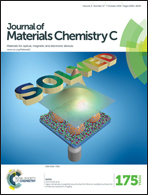Extending two-dimensional π-conjugation length by introducing the alkoxybiphenyl unit for efficient benzodithiophene based photovoltaic polymer†
Abstract
A novel monomer alkoxybiphenyl-substituted benzodithiophene (BDTBP) was synthesized and used as the donor to construct a donor–acceptor copolymer PBDTBP–DTffBT with 4,7-di(4-(2-ethylhexyl)-2-thienyl)-5,6-difluoro-2,1,3-benzothiadiazole (DTffBT) as the acceptor unit. Compared with the corresponding polymer PBDTP–DTffBT based on alkoxyphenyl-substituted BDT, PBDTBP–DTffBT exhibits a red-shifted UV-vis absorption spectra due to its extended π-conjugation structure. The maximum power conversion efficiency (PCE) of PBDTBP–DTffBT based polymer solar cells (PSCs) is 6.70% with Voc = 0.85 V, Jsc = 12.72 mA cm−2 and FF = 62.14%, and the hole mobility is 3.45 × 10−4 cm2 V−1 s−1 while the maximum PCE of PSCs based on PBDTP–DTffBT is only 4.91% and the hole mobility is 1.70 × 10−5 cm2 V−1 s−1. These findings demonstrate that BDTBP unit is a promising building block for constructing a copolymer with high hole mobility, and extending the π-conjugation length on the alkoxyphenyl-substituted BDT is helpful to improve the photovoltaic properties.


 Please wait while we load your content...
Please wait while we load your content...